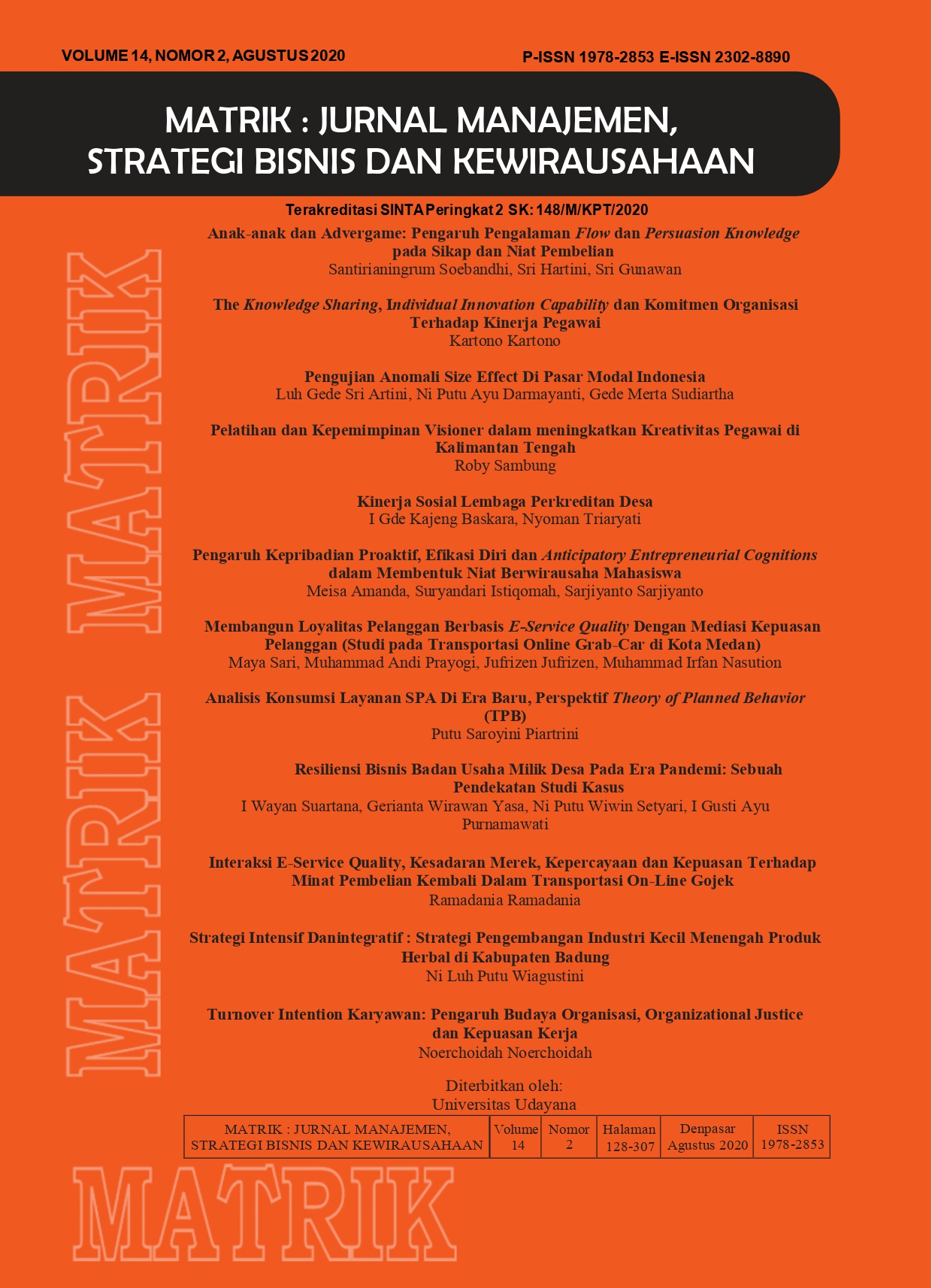Anak-anak dan Advergame: Pengaruh Pengalaman Flow dan Persuasion Knowledge pada Sikap dan Niat Pembelian
Abstract
Playing a video game has become a favorite activity for children. One of the marketing efforts to attract their attention is by combining advertising and entertainment in the form of advergame or advertising game. Childhood is considered as a critical period towards the impact of advertising. As more advergame played especially intended for children, this study aims to analyze the effectiveness of advergame through flow experience and persuasion knowledge towards advergame and brand attitude as well as their purchase intention towards the embedded product in the game. This study was participated by 218 children aged 10-12 years old in Jakarta and Surabaya. Seven hypotheses were proposed to be analyzed further. Different from the previous studies, this study shows that attitudes on advergame do not influence the children intention to purchase the advertised product. The findings also offer some implications, limitations and directions to the future research.
Downloads
References
Ajzen, I. (2008). Consumer Attitudes and Behavior. In C. P. Haugtvedt, P. Herr & F. Kardes (Eds.), Handbook of Consumer Psychology (pp. 525–548). New York: Lawrance Erlbaum Associates.
An, S., & Stern, S. (2011). Mitigating the Effects of Advergames on Children. Journal of Advertising, 40(1), 43-56. doi: 10.2753/JOA0091-3367400103
Bahn, K. D. (1986). How and When do Brand Perceptions and Preferences First Form? A Cognitive Developmental Investigation. Journal of Consumer Research, 13(3), 382-393.
Baker, W. E. (2010). Attitude Behavior Consistency. In J. N. Sheth & N. Malhotra (Eds.), Wiley International Encyclopedia of Marketing: John Wiley & Sons, Ltd.
Belch, G. E., & Belch, M. A. (2018). Advertising & Promotion: An Integrated Marketing Communications Perspective (11th ed.). New York, NY: McGraw-Hill Education.
Bellman, S., Kemp, A., Haddad, H., & Varan, D. (2014). The Effectiveness of Advergames Compared to Television Commercials and Interactive Commercials Featuring Advergames. Computers in Human Behavior, 32, 276–283. doi: 10.1016/j.chb.2013.12.013
Boerman, S. C., Reijmersdal, E. A. v., & Neijens, P. C. (2012). Sponsorship Disclosure: Effects of Duration on Persuasion Knowledge and Brand Responses. Journal of Communication, 62, 1047–1064. doi: 10.1111/j.1460-2466.2012.01677.x
Boerman, S. C., Reijmersdal, E. A. v., & Neijens, P. C. (2013). Appreciation and Effects of Sponsorship Disclosure. In S. Rosengren, M. Dahlén & S. Okazaki (Eds.), Advances in Advertising Research (Vol. IV) - The Changing Roles of Advertising (pp. 273–284). Sweden: Springer.
Bogost, I. (2007). Persuasive Games: The Expressive Power of Videogames. Cambridge: MIT Press.
Bousch, D. M., Friestad, M., & Wright, P. (2009). Deception in the Marketplace: The Psychology of Deceptive Persuasion and Consumer Self Protection. New York: Routledge.
BPS. (2010). Penduduk Menurut Kelompok Umur dan Jenis Kelamin. diakses pada October 5 2016, dari https://sp2010.bps.go.id/index.php/site/tabel?search-tabel=Penduduk+Menurut+Kelompok+Umur+dan+Jenis+Kelamin&tid=336&search-wilayah=Indonesia&wid=0000000000&lang=id
BPS. (2011). Umur dan Jenis Kelamin Penduduk Indonesia: Hasil Sensus Penduduk 2010. Jakarta: Badan Pusat Statistik.
Breckler, S. J., & Wiggins, E. C. (1989). Affect versus Evaluation in the Structure of Attitudes. Journal of Experimental Social Psychology, 25(3), 253-271. doi: 10.1016/0022-1031(89)90022-X
Brucks, M., Armstrong, G. M., & Goldberg, M. E. (1998). Children's Use of Cognitive Defenses Against Television Advertising: A Cognitive Response Approach. Journal of Consumer Research, 14(4), 471-482.
Buckingham, D. (2000). After the Death of Childhood: Growing Up in the Age of Electronic Media. Cambridge: Polity Press.
Buijzen, M., Van Reijmersdal, E. A., & Owen, L. H. (2010). Introducing the PCMC Model: An Investigative Framework for Young People's Processing of Commercialized Media Content. Communication Theory, 20(4), 427-450. doi: 10.1111/j.1468-2885.2010.01370.x
Calvert, S. L. (2008). Children as Consumers: Advertising and Marketing. The Future of Children, 18(1), 205-234. doi: 10.1353/foc.0.0001
Campbell, M. C., & Kirmani, A. (2000). Consumers’ Use of Persuasion Knowledge: The Effects of Accessibility and Cognitive Capacity on Perceptions of an Influence Agent. Journal of Consumer Research, 27(1), 69-83.
Cauberghe, V., & Pelsmacker, P. D. (2010). Advergames. Journal of Advertising, 39(1), 5-18. doi: 10.2753/JOA0091-3367390101
Chen, H. (2006). Flow on the Net–Detecting Web Users Positive Affects and Their Flow States. Computers in Human Behavior, 22, 221–233. doi: 10.1016/j.chb.2004.07.001
Csikszentmihalyi, M. (1990). Flow: The Psychology of Optimal Experience. New York: Harper & Row.
Csikszentmihalyi, M., & Lefevre, J. (1989). Optimal Experience in Work and Leisure. Journal of Personality and Social Psychology, 56(5), 815-822.
Evans, N. J., & Park, D. (2015). Rethinking the Persuasion Knowledge Model: Schematic Antecedents and Associative Outcomes of Persuasion Knowledge Activation for Covert Advertising. Journal of Current Issues & Research in Advertising, 36(2), 157-176.
Friestad, M., & Wright, P. (1994). The Persuasion Knowledge Model: How People Cope with Persuasion Attempts. Journal of Consumer Research, 21(1), 1–31.
Friestad, M., & Wright, P. (1999). Everyday Persuasion Knowledge. Psychology & Marketing, 16(2), 185-194.
Gross, M. L. (2010). Advergames and the Effects of Game-Product Congruity. Computers in Human Behavior, 26(6), 1259-1265. doi: 10.1016/j.chb.2010.03.034
Gunter, B. (2016). Kids and Branding in a Digital World. Manchester: Manchester University Press.
Gurău, C. (2008). The Influence of Advergames on Players' Behaviour: An Experimental Study. Electronic Markets, 18(2), 106-116. doi: 10.1080/10196780802044859
Hair, J. F., Hult, G. T. M., Ringle, C. M., & Sarstedt, M. (2014). A Primer on Partial Least Squares Structural Equation Modeling (PLS-SEM). Thousand Oaks: Sage.
Hair, J. F., Ringle, C. M., & Sarstedt, M. (2011). PLS-SEM: Indeed a Silver Bullet. Journal of Marketing Theory and Practice, 19(2), 139-152. doi: 10.2753/MTP1069-6679190202
Hair Jr, J. F., Sarstedt, M., Hopkins, L., & G. Kuppelwieser, V. (2014). Partial Least Squares Structural Equation Modeling (PLS-SEM): An Emerging Tool in Business Research. European Business Review, 26(2), 106-121. doi: 10.1108/EBR-10-2013-0128
Hall, L. E., Hume, C., & Tazzyman, S. (2016). Five Degrees of Happiness: Effective Smiley Face Likert Scales for Evaluating with Children. Paper presented at the IDC ’16 Proceedings of the The 15th International Conference on Interaction Design and Children Manchester.
Hang, H., & Auty, S. (2011). Children Playing Branded Video Games: The Impact of Interactivity on Product Placement Effectiveness. Journal of Consumer Psychology, 21(1), 65-72. doi: 10.1016/j.jcps.2010.09.004
Hendriyani, Hollander, E., D'Haenens, L., & Beentjes, J. W. J. (2012). Children's media use in Indonesia. Asian Journal of Communication, 22(3), 304-319.
Hernandez, M. D. (2008). Determinants of Children’s Attitudes towards "Advergames": The Case of Mexico. Young Consumers, 9(2), 112-120. doi: 10.1108/17473610810879684
Hernandez, M. D. (2011). A Model of Flow Experience as Determinant of Positive Attitudes Toward Online Advergames. Journal of Promotion Management, 17(3), 315-326. doi: 10.1080/10496491.2011.596761
Hernandez, M. D., Chapa, S., Minor, M. S., Maldonado, C., & Barranzuela, F. (2004). Hispanic Attitudes toward Advergames: A Proposed Model of their Antecedents. Journal of Interactive Advertising, 5(1), 74-83.
Hoffman, D. L., & Novak, T. P. (2009). Flow Online: Lessons Learned and Future Prospects. Journal of Interactive Marketing, 23(1), 23-34. doi: 10.1016/j.intmar.2008.10.003
Hoyer, W. D., MacInnis, D. J., & Pieters, R. (2013). Consumer Behavior (6th ed.). South-Western: Cengage Learning.
Janiszewski, C. (1993). Preattentive Mere Exposure Effects. Journal of Consumer Research, 20(3), 376-392. doi: 10.1086/209356
Jin, S.-A. A. (2011). "I Feel Present. Therefore, I Experience Flow:”A Structural Equation Modeling Approach to Flow and Presence in Video Games. Journal of Broadcasting & Electronic Media, 55(1), 114-136.
John, D. R. (1999). Consumer Socialization of Children: A Retrospective Look at Twenty Five Years of Research. Journal of Consumer Research, 26(3), 183-213.
Kaneva, N. (2007). Viral Marketing. In J. J. Arnett (Ed.), Encyclopedia of Children, Adolescents, and the Media (Vol. 2, pp. 867-868). Thousand Oaks, California: Sage.
Kardes, F., Cronley, M., & Cline, T. (2011). Consumer Behavior. Mason, OH: Cengage Learning.
Kemdikbud. (2018). Data Referensi Pendidikan dan Kebudayaan. diakses pada March 8 2018, dari http://referensi.data.kemdikbud.go.id/index.php
Kominfo. (2013). Jumlah pengguna internet berdasarkan kota di Indonesia tahun 2013. diakses pada March 8 2018, dari https://statistik.kominfo.go.id/site/data?idtree=326&iddoc=1186
Kusumasondjaja, S. (2016). Respon Konsumen pada Mobile Advergames: Intrusiveness dan Irritation. Jurnal Manajemen Teknologi, 15(3), 206-223. doi: 10.12695/jmt.2016.15.3.1
Lang, A. (2000). The Limited Capacity Model of Mediated Message Processing. Journal of Communication, 50(1), 46–70. doi: 10.1111/j.1460-2466.2000.tb02833.x
Lu, A. S., Baranowski, T., Thompson, D., & Buday, R. (2012). Story Immersion of Videogames for Youth Health Promotion: A Review of Literature. Games for Helath Journal: Research, Development, and Clinical Applications, 1(3). doi: 10.1089/g4h.2011.0012
Lutz, R. J. (1985). Affective and Cognitive Antecedents of Attitude Toward the Ad: A Conceptual Framework. In L. F. Alwitt & A. A. Mitchell (Eds.), Psychological Processes and Advertising Effects: Theory, Research and Application (pp. 45-63). Hillsdale, NJ: Erlbaum.
Mackay, T., Ewing, M., Newton, F., & Windisch, L. (2009). The Effect of Product Placement in Computer Games on Brand Attitude and Recall. International Journal of Advertising: The Review of Marketing Communications, 28(3), 423-438. doi: 10.2501/S0265048709200680
Mallinckrodt, V., & Mizerski, D. (2007). The Effects of Playing an Advergame on Young Children's Perceptions, Preferences, and Requests. Journal of Advertising, 36(2), 87-100. doi: 10.2753/JOA0091-3367360206
Mau, G., Silberer, G., & Constien, C. (2008). Communicating Brands Playfully. International Journal of Advertising, 27(5), 827–851. doi: 10.2501/S0265048708080293
Mitchell, A. A., & Olson, J. C. (1981). Are Product Attribute Beliefs the Only Mediator of Advertising Effects on Brand Attitude? Journal of Marketing Research, 18(3), 318-332.
Moore, E. S., & Rideout, V. J. (2007). The Online Marketing of Food to Children: Is It Just Fun and Games? Journal of Public Policy & Marketing, 26(2), 202-220. doi: 10.1509/jppm.26.2.202
Nakamura, J., & Csikszentmihalyi, M. (2002). The Concept of Flow. In C. R. Snyder & S. J. Lopez (Eds.), Handbook of Positive Psychology (pp. 89-105). New York: Oxford University Press.
Nelson, M. R., & Waiguny, M. K. J. (2012). Psychological Processing of In-Game Advertising and Advergaming: Branded Entertainment or Entertaining Persuasion? In L. J. Shrum (Ed.), The Psychology of Entertainment Media: Blurring the Lines Between Entertainment and Persuasion (2nd ed., pp. 93-144). Mahwah, NJ: Taylor and Francis.
Nicovich, S. G. (2005). The Effect of Involvement on Ad Judgment in a Video Game Environment. Journal of Interactive Advertising, 6(1), 29-39. doi: 10.1080/15252019.2005.10722105
Noor, M. N. M., Sreenivasan, J., & Ismail, H. (2013). Malaysian Consumers’ Attitude towards Mobile Advertising and its Impact on Purchase Intention – A Structural Equation Modeling Approach. International Journal of Economics and Statistics, 3(1), 148-155.
Obringer, L. A. (2007). How Advergaming Works. diakses pada 26 September 2016, dari http://money.howstuffworks.com/advergaming.htm/printable
Panic, K., Cauberghe, V., & De Pelsmacker, P. (2013). Comparing TV Ads and Advergames Targeting Children: The Impact of Persuasion Knowledge on Behavioral Responses. Journal of Advertising, 42(2–3), 264-273. doi: 10.1080/00913367.2013.774605
Phelps, J. E., & Hoy, M. G. (1996). The Aad-Ab-PI Relationship in Children: The Impact of Brand Familiarity and Measurement Timing. Psychology & Marketing, 13(1), 77-105.
PwC. (2017). Perspectives from the Global Entertainment and Media Outlook 2017-2021 (Vol. 2017).
Redwing. (2014). Technology is Changing the Face of Advertising in Indonesia. diakses pada 15 Maret 2016, dari http://redwing-asia.com/analysis-posts/technology-changing-face-advertising-indonesia/
Reijmersdal, E. A. v., Rozendaal, E., & Buijzen, M. (2012). Effects of Prominence, Involvement, and Persuasion Knowledge on Children’s Cognitive and Affective Responses to Advergames. Journal of Interactive Marketing, 26, 33–42. doi: 10.1016/j.intmar.2011.04.005
Reynolds-keefer, L., & Johnson, R. (2011). Is a Picture is Worth a Thousand Words? Creating Effective Questionnaires with Pictures. Practical Assessment, Research & Evaluation, 16(8), 1-7.
Rideout, V. J., Foehr, U. G., & Roberts, D. F. (2010). Generation M2: Media in the Lives of 8- to 18-Year-Olds. Menlo Park: CA.
Robertson, T. S., & Rossiter, J. R. (1974). Children and Commercial Persuasion: An Attribution Theory Analysis. Journal of Consumer Research, 1(1), 13-20.
Roedder, D. L., Sternthal, B., & Calder, B. J. (1983). Attitude-Behavior Consistency in Children's Responses to Television Advertising. Journal of Marketing Research, 20(4), 337-349.
Rozendaal, E., Buijzen, M., & Valkenburg, P. (2009). Do Children’s Cognitive Advertising Defenses Reduce their Desire for Advertised Products? . Communications, 34, 287–303. doi: 10.1515/COMM.2009.018
Rozendaal, E., Buijzen, M., & Valkenburg, P. (2010). Comparing Children's and Adults' Cognitive Advertising Competences in the Netherlands. Journal of Children and Media, 4(1), 77-89. doi: 10.1080/17482790903407333
Rozendaal, E., Lapierre, M. A., Reijmersdal, E. A. v., & Buijzen, M. (2011). Reconsidering Advertising Literacy as a Defense Against Advertising Effects. Media Psychology, 14(4), 333-354,. doi: 10.1080/15213269.2011.620540
Rozendaal, E., Slot, N., Reijmersdal, E. A. v., & Buijzen, M. (2013). Children's Responses to Advertising in Social Games. Journal of Advertising, 42(2-3), 142-154. doi: 10.1080/00913367.2013.774588
Sherry, J. L. (2004). Flow and Media Enjoyment. Communication Theory, 14(4), 328-347.
Soebandhi, S., Hartini, S., & Gunawan, S. (2018). Children and Advergame: The Role of Presence, Flow, and Persuasion Knowledge. International Journal of Electronic Business, 14(4), 293-308. doi: 10.1504/IJEB.2018.098126
Soebandhi, S., Hartini, S., & Gunawan, S. (2020). Engaging Young Consumers with Advergames: The effect of Presence and Flow Experience. In R. Hurriyati, B. Tjahjono, I. Yamamoto, A. Rahayu, A. G. Abdullah & A. A. Danuwijaya (Eds.), Advances in Business, Management and Entrepreneurship (pp. 97-101). London: Taylor & Francis Group.
Solomon, M. R. (2018). Consumer Behavior: Buying, Having, and Being. Global Edition (12th ed.): Pearson.
Steffen, C., Mau, G., & Schramm-klein, H. (2013). Who Is the Loser When I Lose the Game? Does Losing an Advergame Have a Negative Impact on the Perception of the Brand? Journal of Advertising, 42(2-3), 183-195. doi: 10.1080/00913367.2013.774598
Terlutter, R., & Capella, M. L. (2013). The Gamification of Advertising: Analysis and Research Directions of In-Game Advertising, Advergames, and Advertising in Social Network Games. Journal of Advertising, 42(2-3), 95-112. doi: 10.1080/00913367.2013.774610
Vanwesenbeeck, I., Ponnet, K., & Walrave, M. (2016). Go with the flow: How children’s persuasion knowledge is associated with their state of flow and emotions during advergame play. Journal of Consumer Behaviour, 47(1), 38-47. doi: 10.1002/cb
Verhellen, Y., Oates, C., Pelsmacker, P. D., & Dens, N. (2014). Children’s Responses to Traditional Versus Hybrid Advertising Formats: The Moderating Role of Persuasion Knowledge. Journal of Consumer Policy, 37(2), 235–255. doi: 10.1007/s10603-014-9257-1
Vermeir, I., Kazakova, S., Tessitore, T., Cauberghe, V., & Slabbinck, H. (2014). Impact of Flow on Recognition of and Attitudes towards In-Game Brand Placements. International Journal of Advertising, 33(4), 785-810. doi: 10.2501/IJA-33-4-785-810
Voges, K., Pope, N., & Brown, M. (2003). Buying or Browsing? An exploration of Shopping Orientations and Online Purchase Intention. European Journal of Marketing, 37(11/12), 1666-1684. doi: 10.1108/03090560310495401
Waiguny, M. K. J. (2013). Investigating the Entertainment–Persuasion Link: Can Educational Games Influence Attitudes Toward Products? In S. Rosengren, M. Dahlén & S. Okazaki (Eds.), Advances in Advertising Research (Vol. IV) - The Changing Roles of Advertising (pp. 173–186): Springer Fachmedien Wiesbaden.
Waiguny, M. K. J., Nelson, M. R., & Terlutter, R. (2012). Entertainment Matters! The Relationship between Challenge and Persuasiveness of an Advergame for Children. Journal of Marketing Communications, 18(1), 69-89.
Waiguny, M. K. J., & Terlutter, R. (2010). Entertainment in Advergames and its Influence on Brand-Related Outcomes for Children. In R. Terlutter, S. Diehl & S. Okazaki (Eds.), Advances in Advertising Research (Vol. 1) (pp. 171–186). Germany: Gabler.
Waiguny, M. K. J., Terlutter, R., & Zaglia, M. E. (2011). The Influence of Advergames on Consumers’ Attitudes and Behaviour: An Empirical Study among Young Consumers. International Journal of Entrepreneurial Venturing, 3(3), 231-247. doi: 10.1504/IJEV.2011.041273
Wright, P., Friestad, M., & Boush, D. M. (2005). The Development of Marketplace Persuasion Knowledge in Children, Adolescents, and Young Adults. Journal of Public Policy & Marketing, 24(2), 222-233.
Youn, S., & Mira, L. (2012). In-Game Advertising and Advergames: A Review of the Past Decade’s Research. In S. Rodgers & E. Thorson (Eds.), Advertising Theory (pp. 388-401). New York: Routledge.
Zajonc, R. B. (1968). Attitudinal Effects of Mere Exposure. Journal of Personality and Social Psychology, Monograph Supplement, 9(2), 1-27.
Zillmann, D. (1971). Excitation Transfer in Communication-mediated Aggressive Behavior. Journal of Experimental Social Psychology, 7, 419–434. doi: 10.1016/0022-1031(71)90075-8
Zillmann, D. (2007). Arousal Theories. In J. J. Arnett (Ed.), Encyclopedia of Children, Adolescents, and the Media (pp. 101-104). Thousand Oaks: Sage Publications.
 This work is licensed under a Creative Commons Attribution-ShareAlike 4.0 International License.
This work is licensed under a Creative Commons Attribution-ShareAlike 4.0 International License.

















